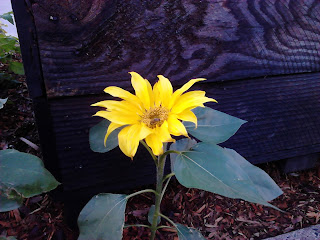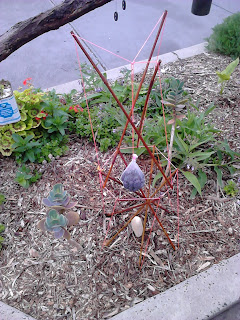I spend some time bringing some more images of the front yard to me, reminding me of the transformation that took place of a weedy patch in front of a commercial warehouse. I could have edited the first part, and added photos, but I decided to continue in good old blogging fashion, retell the story with maybe repeated, maybe new elements guided by the visual aid.
That's how it looked like when it started, or so I thought before I went back to google maps. So let me interrupt here my own narrative for a second to provide some 'historical' background. According to our lovely neighbour next door, this specific patch used to be a permanent eyesore.
Google's prying eyes saw this barren patch of unused green strip in November 2007, probably popular with neighbourhood dogs, handy to drive over occasionally to park in front of the warehouse.
Two years later an attempt to utilise the space was made. The fencing suggests guarding something precious, but it certainly prevents uninvited canine friends. It looks like a rosemary bush acted as centre piece. The combination of deteriorating eyesight, low resolution and lack of botanical knowledge make this a pure guess. Never trust anything on the internet, research for yourself.
In January 2014 the fence was gone, only the hardy rosemary remained in an otherwise unexciting stretch of weeds.
You can't see the rosemary from this perspective, it lurks behind the compost bin. I took this shot in January 2015, using the wild constellation of random objects as backdrop for one of my tensegrity structures.
Composting was one way of showing how sustainability begins at home, but it took an accidence to get the work started. We reunited two parts of the same branch as an arch, weeding and digging the whole patch, leaving only the rosemary and a healthy parsley bush behind.
The beautiful aloe vera plant had changing luck - after mulching the entire bed it got dug under by some nasty dog for some weeks. It took months to get it back to health, until someone unrequested gave it a new home.
While some of the succulents grew prolific, it took Adrian to introduce more of the leafy and flowering parts of the garden.
The sunflowers didn't grow tall, and I don't know whether any of the seeds would germinate. Having about a dozen tiny sunflowers guarding the garden provided a great sprinkle of colour.
I enjoyed watching different parts of the garden grow, but there seemed to be space more. I wanted to experiment with a tensegrity structure as support for ranking plants. Unfortunately, although I manage to make it relatively wind proof, it was certainly not fool proof. I lost a couple tomato plants when someone stepped onto the structure, breaking a strut.
Comfrey certainly made the biggest attempt to take over. I need to get into the habit of drying and using plants growing in 'wrong' spots, it can't harm to have some supplies of the 'bone-healing' herb.
The compost bin remains in the same place like last year, just like the arc we build. Yet the rosemary bush gained lots of company since then.













